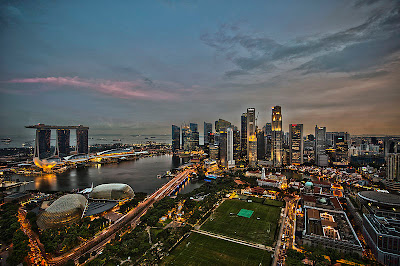The East gets a taste of Fairlynch
Fairlynch Museum prides itself on growing global links. Our Local
History Group regularly receives enquiries from people on the other side of the
world asking if we can provide information about their Devon
ancestors.
Singapore city skyline at dusk Image credit: Chensiyuan

"The joy of introducing a child or child-at-heart to
our wild places," is a special experience, she says. "To see in their eyes, the fascination
and realisation of how nature can make us whole again." Her favourite way
is to share the experience personally during a guided walk. Another way is
through photographs, which capture what she describes as the wondrous qualities
of Singapore
Singapore city skyline at dusk Image credit: Chensiyuan
We've just had an email from the USA
And my research into the life and work of Henry John Carter
for the forthcoming Sea, Salt and Sponges exhibition has led me to contact
people in places ranging from the Netherlands
to Japan , from India to California
After all, HJC as I'll call Budleigh's most distinguished
scientist did spend over 20 years of his life exploring the deserts and coasts
of Arabia before settling in India

So a contact with Singapore shouldn't have surprised me,
given that one of the many sponges named
after HJC includes the Coelocarteria singaporensis otherwise known as the Daisy Sponge, considered among the
most commonly seen sponges in Singapore.
Image credit: Gary C. Williams, California Academy of Sciences
Wildlife enthusisast Ria Tan on
the tiny islet Pulau Sekudu also known as Frog Island, with the wetlands of Chek Jawa in the background
What did surprise was Singapore Singapore
Ria reveals another side of Singapore
Pseudoceratina purpurea (Carter, 1880) also known as Yellow prickly branching Sponge, with very pregnant seahorse
Image credit: Ria Tan www.wildsingapore
Originally enthused by her experience as a volunteer guide
at the wetland reserve of Sungei Buloh https://www.sbwr.org.sg/ she then, as
she writes, fell under the spell of the 100-hectare wetlands of Chek Jawa with
their unique and rich ecosystems first discovered in the early 2000s. She soon
got involved in other wildlife reserves in Singapore
Henry Carter would be delighted to find that his work is
being remembered in Singapore






Comments
Post a Comment